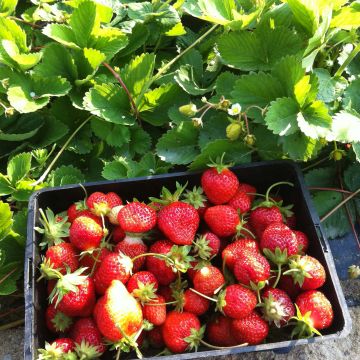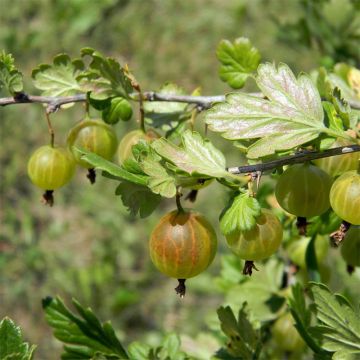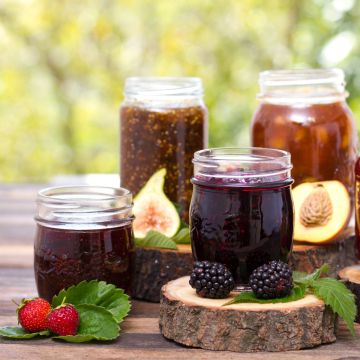

Vigne Cabernet Sauvignon - Vitis vinifera
Vitis vinifera Cabernet Sauvignon - Grape vine
Vitis vinifera Cabernet Sauvignon
Common Grape Vine, European Grape, Wine Grape
good
Jon H., 23/05/2020
Special offer!
Receive a €20 voucher for any order over €90 (excluding delivery costs, credit notes, and plastic-free options)!
1- Add your favorite plants to your cart.
2- Once you have reached €90, confirm your order (you can even choose the delivery date!).
3- As soon as your order is shipped, you will receive an email containing your voucher code, valid for 3 months (90 days).
Your voucher is unique and can only be used once, for any order with a minimum value of €20, excluding delivery costs.
Can be combined with other current offers, non-divisible and non-refundable.
Home or relay delivery (depending on size and destination)
Schedule delivery date,
and select date in basket
This plant carries a 6 months recovery warranty
More information
We guarantee the quality of our plants for a full growing cycle, and will replace at our expense any plant that fails to recover under normal climatic and planting conditions.

Description
The Cabernet Sauvignon vine is an ancient grape variety, widely cultivated in Gironde and southwestern France where it is used in the production of the Médoc, Graves, Saint Emilion, Bergerac, and Pécharmant appellations. Vigorous and productive, it produces clusters of small grapes with thick, pruinose, black-blue skins. The firm and crunchy flesh has a characteristic flavor and reveals a certain astringency on the palate. The harvest, which is moderately early, takes place in September-October, depending on the climate and the year, about a week before that of the black Merlot and black Carignan. The Cabernet Sauvignon vine is quite susceptible to fungal diseases and it is preferable to avoid large pruning wounds. It is a wine grape.
The wine vine, in Latin Vitis vinifera, grew wild over 5000 years ago. It was introduced to France for cultivation by the Romans. Numerous hybrids have been created to vary colors, flavors, and uses. The Cabernet Sauvignon vine is believed to originate from Gironde. It is listed in the Official Catalogue of Vine Varieties. This grape variety is the result of a crossbreeding between Cabernet Franc and Sauvignon Blanc.
A vigorous climbing woody shrub, the Cabernet Sauvignon vine can easily reach a height or spread of 4-5m (13-16ft) if not pruned. It is recommended to train it on wire trellises and practice long pruning. Its final shape will depend on the pruning method used. The Cabernet Sauvignon vine is a frugal sun-loving plant that prefers a soil that is both clayey and stony, well-drained. Its long stems naturally cling to their support (trellis, espalier...) through large green and voluble tendrils. Leafing out occurs quite late. Its foliage, with serrated edges, is a deep green in summer and turns into the most beautiful gold in autumn. It flowers in May-June depending on the year and region, offering tiny greenish to white-pink flowers gathered in short, moderately compact, pyramid-shaped and cylindrical clusters. Its small, round and firm grapes have a thick skin covered with bloom, turning black-blue when fully ripe. Depending on the terroir, they reveal various aromas: blackcurrant leaf, tobacco, truffles, Morello cherry, blackberry, green bell pepper, vanilla, violet, dark chocolate, sweet spices, fern, smoke, plum, licorice, undergrowth... The Cabernet Sauvignon grape brings tannic structure and deep color to the wine, excellent aging potential, and the ability to be aged in oak barrels. On its own, it may lack roundness.
The Cabernet Sauvignon grape is consumed after vinification. It can also be used for ornamentation in a pergola, against a sunny wall, or trained on a trellis.
Report an error about the product description
Vitis vinifera Cabernet Sauvignon - Grape vine in pictures




Plant habit
Fruit
Flowering
Foliage
Botanical data
Vitis
vinifera
Cabernet Sauvignon
Vitaceae
Common Grape Vine, European Grape, Wine Grape
Cultivar or hybrid
Other Grapevines
View all →Planting and care
Since the ravages of phylloxera in the late 19th century, the vine is obligatorily grafted onto different resistant rootstocks to this disease and adapted to different types of soil. These rootstocks come from naturally resistant American varieties against this formidable parasite itself of American origin. Plant the Cabernet Sauvignon vine in autumn, in a deep, well-drained soil, even stony, clayey and chalky (according to the rootstock), in a well-sunny exposure, sheltered from strong winds. Incorporate into the planting soil 3 or 4 handfuls of fertilizer for fruit trees and 2 kg of composted manure for each vine-plant. The roots should not be in contact with the manure. After planting, prune above 2 large buds (buds) to obtain the development of two branches. Keep the most vigorous one and tie it to a stake. Follow with training pruning. Susceptible to fungal diseases, it will require regular treatments, especially in our rainy regions. Avoid large pruning wounds.
The vine does not require regular fertilizer application for good yields, on the contrary. Enrich the soil with potash slag, crushed horn or iron chelate, only every 2-3 years.
Planting period
Intended location
Care
-
, onOrder confirmed
Reply from on Promesse de fleurs
Similar products
Haven't found what you were looking for?
Hardiness is the lowest winter temperature a plant can endure without suffering serious damage or even dying. However, hardiness is affected by location (a sheltered area, such as a patio), protection (winter cover) and soil type (hardiness is improved by well-drained soil).

Photo Sharing Terms & Conditions
In order to encourage gardeners to interact and share their experiences, Promesse de fleurs offers various media enabling content to be uploaded onto its Site - in particular via the ‘Photo sharing’ module.
The User agrees to refrain from:
- Posting any content that is illegal, prejudicial, insulting, racist, inciteful to hatred, revisionist, contrary to public decency, that infringes on privacy or on the privacy rights of third parties, in particular the publicity rights of persons and goods, intellectual property rights, or the right to privacy.
- Submitting content on behalf of a third party;
- Impersonate the identity of a third party and/or publish any personal information about a third party;
In general, the User undertakes to refrain from any unethical behaviour.
All Content (in particular text, comments, files, images, photos, videos, creative works, etc.), which may be subject to property or intellectual property rights, image or other private rights, shall remain the property of the User, subject to the limited rights granted by the terms of the licence granted by Promesse de fleurs as stated below. Users are at liberty to publish or not to publish such Content on the Site, notably via the ‘Photo Sharing’ facility, and accept that this Content shall be made public and freely accessible, notably on the Internet.
Users further acknowledge, undertake to have ,and guarantee that they hold all necessary rights and permissions to publish such material on the Site, in particular with regard to the legislation in force pertaining to any privacy, property, intellectual property, image, or contractual rights, or rights of any other nature. By publishing such Content on the Site, Users acknowledge accepting full liability as publishers of the Content within the meaning of the law, and grant Promesse de fleurs, free of charge, an inclusive, worldwide licence for the said Content for the entire duration of its publication, including all reproduction, representation, up/downloading, displaying, performing, transmission, and storage rights.
Users also grant permission for their name to be linked to the Content and accept that this link may not always be made available.
By engaging in posting material, Users consent to their Content becoming automatically accessible on the Internet, in particular on other sites and/or blogs and/or web pages of the Promesse de fleurs site, including in particular social pages and the Promesse de fleurs catalogue.
Users may secure the removal of entrusted content free of charge by issuing a simple request via our contact form.
The flowering period indicated on our website applies to countries and regions located in USDA zone 8 (France, the United Kingdom, Ireland, the Netherlands, etc.)
It will vary according to where you live:
- In zones 9 to 10 (Italy, Spain, Greece, etc.), flowering will occur about 2 to 4 weeks earlier.
- In zones 6 to 7 (Germany, Poland, Slovenia, and lower mountainous regions), flowering will be delayed by 2 to 3 weeks.
- In zone 5 (Central Europe, Scandinavia), blooming will be delayed by 3 to 5 weeks.
In temperate climates, pruning of spring-flowering shrubs (forsythia, spireas, etc.) should be done just after flowering.
Pruning of summer-flowering shrubs (Indian Lilac, Perovskia, etc.) can be done in winter or spring.
In cold regions as well as with frost-sensitive plants, avoid pruning too early when severe frosts may still occur.
The planting period indicated on our website applies to countries and regions located in USDA zone 8 (France, United Kingdom, Ireland, Netherlands).
It will vary according to where you live:
- In Mediterranean zones (Marseille, Madrid, Milan, etc.), autumn and winter are the best planting periods.
- In continental zones (Strasbourg, Munich, Vienna, etc.), delay planting by 2 to 3 weeks in spring and bring it forward by 2 to 4 weeks in autumn.
- In mountainous regions (the Alps, Pyrenees, Carpathians, etc.), it is best to plant in late spring (May-June) or late summer (August-September).
The harvesting period indicated on our website applies to countries and regions in USDA zone 8 (France, England, Ireland, the Netherlands).
In colder areas (Scandinavia, Poland, Austria...) fruit and vegetable harvests are likely to be delayed by 3-4 weeks.
In warmer areas (Italy, Spain, Greece, etc.), harvesting will probably take place earlier, depending on weather conditions.
The sowing periods indicated on our website apply to countries and regions within USDA Zone 8 (France, UK, Ireland, Netherlands).
In colder areas (Scandinavia, Poland, Austria...), delay any outdoor sowing by 3-4 weeks, or sow under glass.
In warmer climes (Italy, Spain, Greece, etc.), bring outdoor sowing forward by a few weeks.


















































